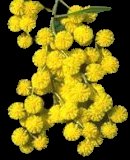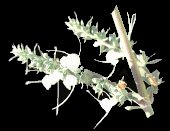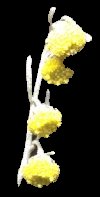|
**disclaimer: If any of the images belong to you and if you want credit or want them removed please email me**
MEANINGS & LEGENDS OF FLOWERS (W)

 Wallflower
Wallflower
Cheiranthus allionii
Family: Brassicaceae
Common Names: ~Wall Violet~ ~Winter Gillflower~ ~Blood-drops-of-Christ~ ~Bloody Warrior~
Wallflower is native to the Canary Islands. It has vivid orange flowers. The leaves are narrow and can withstand dry or moist conditions once established.
The cheiranthus cheiri also known as ~Bloody Warrior,~ had it legendary origin in a castle on the Tweed.
The daughter of the lord fell in love with the laird of a neighbouring clan, hated by her father. Their love affair was discovered, and the maid was confined to the castle. The lad in the disguise of a minstrel, strummed his lute and sang a tale beneath her window. When she heard a moor-cock call in the night, she had to slip from her room to the rampart, with the rope he would throw to her. The call was sounded, the maid crept out and caught the rope that was thrown to her, but she fastened it improperly and fell on stones and died. The powers of white magic that prevailed about the place took pity and changed her body to the wallflower.

 Water lily
Water lily
Nymphaea odorata
Family: Nymphaeaceae
Known as the ~Queen of the Water,~ it is found in shallow ponds, streams, and lakes. According to an Indian legend, the water lily was once a star. It fell from the sky on the water and changed into a flower.
The giant water lily is the Amazon, or Royal water lily ~Victoria amazonica~, found in the Amazon Valley. It has flowers with a circumference of more than 18 inches (45 centimeters) and flat leaves 2 to 6 feet in diameter. The upper surface of the leaves is bright green and the underside a vivid crimson. The leaves are firm enough to bear the weight of a child. Legend about the giant water lily goes...
An Indian girl of one of the Brazilian tribes was told by her father of an ancient belief that a handsome and powerful warrior-god lived in the moon. She believed the tale and fell in love with the warrior-in-the-moon. After that, no boy of her tribe seemed worthy of her affection. Her family's efforts to marry her failed.
She waited patiently, during the days when the moon was not visible and when it emerged in its full splendor each lunar cycle, she would spend hours staring into the sky, trying to see the face of her imagined love. Often she would run through the jungle, as the moon shone at its fullest, trying to catch its rays and embrace her warrior lover. Her parents and friends despaired of ever convincing her that the passion she felt was a mere illusion.
One night when a full moon shone in a cloudless sky, she went into the jungle, this time determined to embrace the moon-warrior and have him forever. She raced further in the jungle and came upon a glass-like lake where she saw the reflection of the moon. She thought, that the moon warrior had come down to Earth, to bathe in a pool and without a moment's hesitation, she planged into the lake to meet him but she drowned in the pool.
The warrior-in-the-moon, so goes the legend, took pity on the girl who had loved him so much that she had died in desperation trying to embrace him. Filled with remorse, but without the power to bring her back to life, he resolved to make her a star on Earth. He transformed the dead girl into a star of the fresh flowing waters of the Amazon River. The star is now the giant flower which reigns supreme as queen of all aquatic plants.
The Indian girl was transformed into the giant water lily, the ~Vitória-régia~ whose flower opens wide only at night.
It is said that the ~Vitória-régia~ opens itself to its utmost only full moon when the sky over the Amazon jungle is cloudless and particularly clear.

 Wattle
Wattle
Acacia pycnantha
Family: Mimosaceae
Wattle is widely grown all over Australia and was named by the English settlers who used it to build their huts at the end of the 18th century. Twigs from these trees were used to weave fences and house walls and they packed cow dung and mud, inbetween the woven twigs, to strengthen the walls and make them wind proof. This type of building was called wattle-and-daub. In England, ~to wattle~ meant to use twigs to weave such constructions.
There are 750 different kinds of wattle.
It is still used today to make fine furniture. It has been shown in coins and represented as the symbol of developing literature.
It blossoms with the coming of Spring, in most parts of Australia the wattle heralds the coming of warmer weather. Australia's national floral emblem is Golden Wattle. Wattle Day is celebrated on 1 September.

 White Sage
White Sage
Salvia apiana
Family : Lamiaceae
Common Name: ~Bee Sage~
White sage is a powerful herb for spiritual or medicinal purposes. The name ~salvia~ comes from the Latin word ~salveo,~ meaning ~to heal~ and ~apiana~ refers to the bees that are attracted to its small white flowers.
White Sage is highly revered by American Indians and it is a sacred plant to many tribes. They believe that the smoke is useful not only for the purification of the body but also for material objects. It has been an integral part in many Indian ceremonies such as prayers, vision quests, the sun dance, or sweat lodges. Some tribes boil up wild sage into a tea to splash on the heated stones when more steam is required, as well as to splash on their own bodies. Other tribes place pieces of sage in between the firewood, in the belief that the plant will help to purify even the fire itself. In the Lakota yuwipi ceremony, a stem of sage is placed behind the right ear so that the spirits will know you.
Sage has been associated with longevity and strength. At one period in time the Chinese carried on a barter trade with Dutch merchants, exchanging as much as three times the weight of their own tea for the sage.
It has any medicinal properties and in many countries has been used as an anti fever remedy. Jamaicans used a cooling drink of sage tea as a treatment against fevers, while American Indians have applied sage tea rubdowns and sage baths to reduce fever. Some Indian tribes have used a salve of the leaves mixed with grease to treat skin sores.

 Wormwood
Wormwood
Artemisia absinthium
Family : Compositae
Common Names: ~Common Wormwood~ ~Absinth~
Native of Eurasia, Artemisia is derived from ~Artemis~ the Greek goddess associated with the moon, and ~absinthium~ means ~without sweetness.~ The plant with its silvery foliage glows in the moonlight. The first mention of the Wormwood is in the Ebers papyrus, a medical document dating to 1550 B.C. The Egyptians used it as a vermifuge and the name ~Wormwood~ may refer to it's property of ridding the body of worms. The name according to some is a corruption of the German ~vermut,~ which means ~preserver of the mind~ referring to its property of ~altering the mental state.~
Wormwood is the bitterest herb known and it's symbolic association is with ~bitterness of spirit. ~ An ancient legend about Queen Artemis of Caria, tells us that when her husband, King Mausolus, disappeared, she sent searchers looking for him but he was nowhere to be found. She assumed he was dead, and started to build a great monument for him. Although Mausolos did return, he was buried in that tomb (one of the wonders of the ancient world) and gave us the term mausoleum, and Artemis became associated with grief, bitterness, and absence.
The Bible refers to wormwood a number of times. A Christian legend says that wormwood sprang up in serpent's path as it left the Garden of Eden, as a barrier to prevent its return. It is said that snakes cannot enter a garden where wormwood grows.
Wormwood was used with wine and beer. In Europe, wormwood was used to bitter beer and was once used to flavor absinthe, a drink which has been banned in its native France since 1915 because ingestion of too much will cause incurable damage to the central nervous system.
The Common Wormwood was highly regarded as a medicine by the Ancients. It was one of the ~strewing herbs~ and laid among things and clothes to keep away moths and insects. Wormwood counteracted the effects of poisoning by hemlock, toadstools. Women applied it to their nipples to encourage the weaning of babies. It was used in poultices. It was said to ward off plague and was used as an ingredient in a love charms. The Mexicans, celebrated their festival of the Goddess of Salt by a ceremonial dance of women, who wore on their heads garlands of Wormwood.

 Woodruff
Woodruff
Galium odoratum
Family: Rubiaceae Juss.
Common Name: ~Sweet Woodruff~
Sweet Woodruff was hung in Medieval churches during religious holidays. In early England it was used in sachets and garlands. In Germany it is used to flavor May wine as a traditional way to greet this spring month and is referred to as Waldmeister meaning ~master of the forest.~ This practice originated in the 13th century, and Germans still serve the Mai Bowle.
During the Middle AgesIt was used for healing cuts and wounds and also used for treating liver conditions. It was also used to deter insects and mixed with snuff to improve the fragrance.
The plant has small white flowers in the summer, and has narrow leaves which will stick to almost anything. The seeds take about 200 days to germinate. The flowers are used for making wreaths and garlands and the leaves in potpourri and herb pillows. The leaves are also used for making a drink. In herbal folklore it signifies humility.
|


Copyright © Pinkie D'Cruz 1998
Friday, January 16, 1998


|